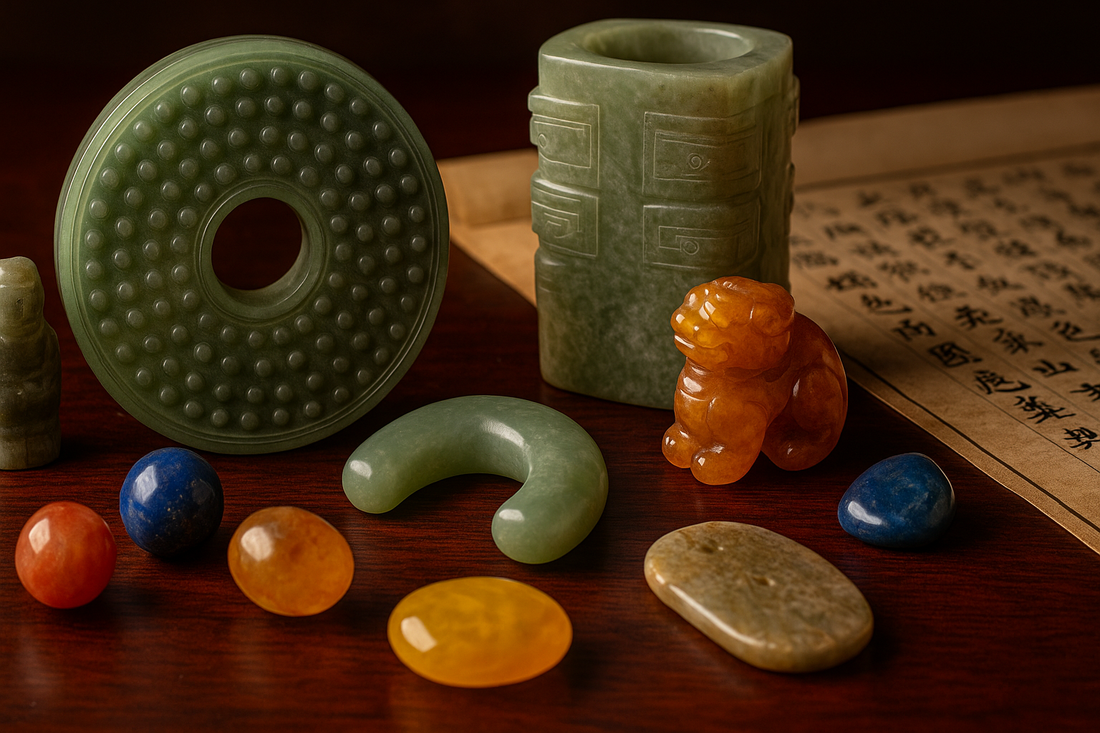
Gemstone Trading in Ancient China
Cody ManesShare
TL;DR
Gemstone trading in ancient China spanned millennia, beginning with jade in the Neolithic and later expanding into international exchanges through the Silk Road. Stones symbolized power, morality, and immortality. While jade remained central, imported gems such as lapis lazuli, carnelian, sapphire, and amber reshaped Chinese art, ritual, and global trade connections.
Key Facts
| Aspect | Detail |
|---|---|
| Main Stone | Jade (nephrite, later jadeite) |
| Earliest Use | Liangzhu culture, c. 3300–2200 BCE |
| Dynastic Peak | Han Dynasty (206 BCE–220 CE) |
| Imported Gems | Lapis lazuli, carnelian, sapphire, amber |
| Trade Routes | Silk Road (land + sea) |
| Cultural Role | Purity, virtue, immortality, cosmic order |
Q&A
Q: Why was jade considered more valuable than gold in ancient China, and what made it unique?
A: Jade embodied Confucian ideals of purity, balance, and resilience. It was considered the physical essence of heaven and earth, carrying spiritual and protective power that gold could not match. Unlike gold, which symbolized wealth, jade signified morality and cosmic harmony, making it irreplaceable in both philosophy and ritual.
Q: How did the Silk Road shape gemstone trade and influence Chinese culture?
A: The Silk Road linked China to India, Persia, and the Mediterranean. Alongside silk and spices, gems like lapis lazuli and carnelian flowed into China, while nephrite jade traveled outward, influencing artistic traditions abroad. This influx of foreign stones introduced new aesthetics, expanded artistic expression, and reinforced China’s role in global exchange.
Q: Did gemstones play a role in Chinese religion and philosophy?
A: Yes. Taoists used jade and cinnabar in alchemy, Buddhists valued imported stones for icons, and Confucianism elevated jade as the moral exemplar of human character. Gemstones were not only decorative but also deeply symbolic, serving as ritual tools, talismans of immortality, and ethical reminders across belief systems.
Deep Dive
Early Jade Culture in Neolithic and Dynastic China | Symbolism and Virtue
Jade was the cornerstone of early Chinese gemstone culture. Archaeological evidence from the Liangzhu culture (c. 3300–2200 BCE) reveals a sophisticated system of jade production and use. Artifacts like bi disks and cong tubes carried cosmological meaning, with circular forms symbolizing heaven and square shapes representing earth. These ritual objects were buried in elite tombs, reinforcing the stone’s role as a bridge between humans and the divine.
During the Shang dynasty (c. 1600–1046 BCE), jade took on more formalized roles in state rituals. Jade blades, ornaments, and scepters were status symbols reserved for kings and nobles. The Zhou dynasty (1046–256 BCE) expanded on this tradition, using jade to embody moral philosophy. Confucius himself praised jade for its clarity, smoothness, and strength, comparing it to virtues such as benevolence, righteousness, and wisdom. In this way, jade became not just a material but a moral guidepost for Chinese civilization.
By the Han dynasty, jade burial suits appeared, intricately crafted from hundreds of plaques sewn with gold or silver thread. These suits reflected the belief that jade could protect the body from decay and help the soul ascend. The famous tomb of Prince Liu Sheng contained a suit of over 2,000 plaques, symbolizing the stone’s enduring role in immortality practices.
Imperial Dynasties and the Expansion of Gemstone Imports | Silk Road and Maritime Routes
While jade remained dominant, the Han dynasty marked a turning point as foreign gems began to flow into China. The opening of the Silk Road brought lapis lazuli from Afghanistan, carnelian from India, and amber from the Baltic regions. These stones were prized for their rarity and integrated into local traditions, often being reinterpreted through Chinese cosmology.
The Tang dynasty (618–907 CE) saw unprecedented openness to foreign cultures. Chang’an, the Tang capital, became a hub where Persian merchants, Indian monks, and Central Asian traders brought gemstones, spices, and textiles. Imported sapphires and garnets were embedded into Buddhist icons, while pearls and turquoise adorned the robes of nobility. Chinese poets and artists described these stones in vivid imagery, associating them with wealth, spiritual purity, and cosmic harmony.
By the Song dynasty (960–1279 CE), maritime routes further expanded gemstone imports. Ports like Guangzhou facilitated exchanges with Southeast Asia, India, and the Middle East. This era also saw increasing demand for jadeite from Burma (modern-day Myanmar), which would eventually eclipse nephrite as the preferred jade variety during the Ming and Qing dynasties.
Gemstones in Religion, Ritual, and Philosophy | Taoism, Buddhism, and Confucian Thought
Gemstones in China were deeply enmeshed in spiritual practice. Taoist alchemists used jade and cinnabar in their search for immortality, grinding them into powders or elixirs believed to confer eternal life. These practices, though sometimes fatal due to mercury poisoning, reflected the deep association between minerals and transcendence.
With the arrival of Buddhism in the Han dynasty, gemstones gained new symbolic roles. Sutras mention seven treasures, including gold, silver, lapis lazuli, crystal, agate, red pearl, and carnelian, which adorned stupas and sacred images. Buddhist monks carried crystals and beads as meditation aids, while temples commissioned statues encrusted with imported gems.
Confucianism, meanwhile, continued to uphold jade as the moral stone. Texts described jade’s translucence as sincerity, its strength as wisdom, and its durability as integrity. Scholars wore jade pendants as reminders of ethical conduct, while emperors gifted jade seals as symbols of rightful rule. Thus, gemstones were woven into the philosophical fabric of Chinese life, serving as moral exemplars, religious tools, and protective talismans.
Sources
Rawson, Jessica. Chinese Jade: From the Neolithic to the Qing. British Museum Press.
Hansen, Valerie. The Silk Road: A New History. Oxford University Press.
Loewe, Michael. Everyday Life in Early Imperial China. Charles Scribner’s Sons.
GIA – Gem Encyclopedia
International Gem Society – Jade Guide
